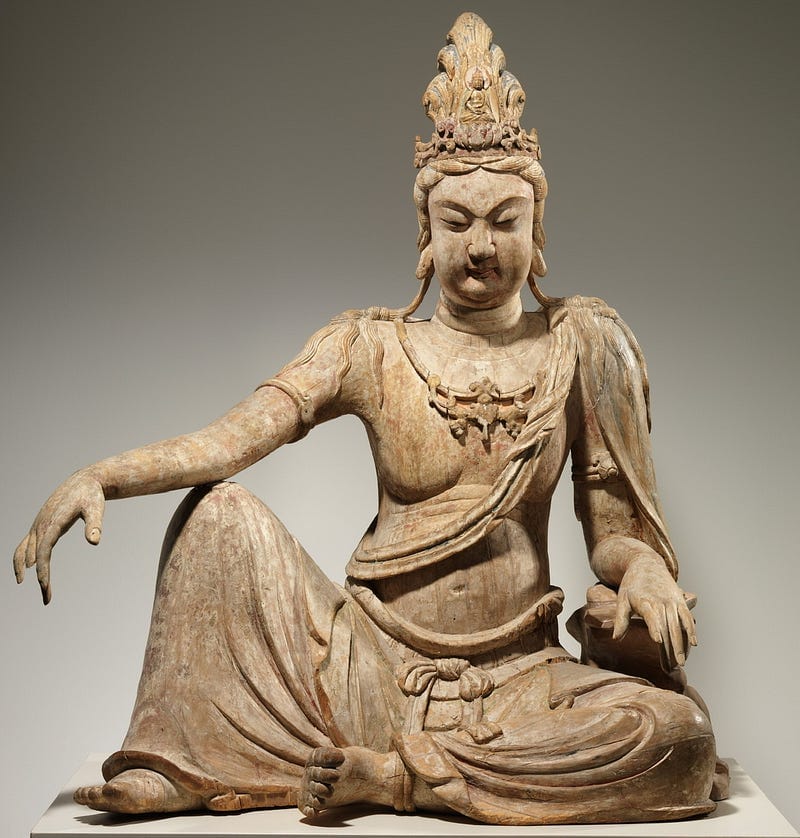👈 || UNSAYING | CONTEMPLATION | TRADITION | MEDITATION | DISCUSSIONS | BACK MATTER || 👉
There is a special deity in Buddhism whose very name today is illustrative of the process of slow change by which knowledge is lost or degenerates into misunderstood meanings, becomes something different than what was intended, and at times, can even become dogmatic ignorance.
This is not the latter case, but rather a tale about how changes accumulate, through compounding misunderstanding, and later interpretative modifications, that are — individually — neither malevolent in design, nor desired for their ultimate effect.
Instead, they are merely the end result of shallow understandings or incomplete knowledge that accumulate and multiply until the original truth is lost. Such ignorance and misunderstanding are the direct result of insufficient effort and distraction — so prevalent in all but the most dedicated individuals — and reflect the dangerous decision, often taken by those that should know better, to make things easier for the hearer to understand, which, when combined with the desire to reach the largest possible audience, ultimately ruins the intended meaning, perhaps forever.
This particular Bodhisattva is of interest because of an association with the meditation support presented in this text. The deity in question was originally named Avalokitasvara. Unfortunately, that is no longer the name used, as today it is Avalokiteśvara, and its various translations in different cultures. And although the spelling change seems insignificant — “eś” rather than “as” — if we examine what has occurred, we can see a great difference in what the current name says and implies about this now deity and lord, and what was originally the case with the heroic entity it named:
There can be no reasonable doubt, then, that the original name of the great bodhisattva ended in “-svara,” denoted by the Chinese “-yin,” either as in Avalokitasvara, Kuan-yin, or as in Avalokitalokasvara, Kuan-shih-yin. The translation of the last two syllables of these names, -svara, is relatively straightforward: it means “sound,” “noise,” or “voice,” being used, for instance to denote the different notes of a musical scale. The first five syllables, avalokita-, are slightly more problematic however, being a past participle form of a verb avalok, usually translated to mean “to look upon or at, view, behold, see, notice, observe.” The natural translation of Avalokitasvara, then, would be something like “the sound that is seen,” which makes little obvious sense.¹
Note how the author of the study quoted, Alexander Studholme, remarks that the natural translation of the bodhisattva’s original name “makes little obvious sense.” This would be the case if those hearing the name were unaware of the particular support that Avalokitasvara used in his practice to reach enlightenment.
But as you will come to see as we delve deeper into the actual practices, “sound that is seen” might refer to the fact that at a certain point, while focusing our attention upon the self-arising (autogenous) resonances of our spontaneous and ephemeral naturing, which arise first as sound in the mind, later combine with colors and patterns to form visionary experiences, such as those used today in the advanced practice within Tibetan Dzogchen known as Tögal. In a fashion similar to what we see today in the practical demonstrations of Cymatics where sound is used to vibrate a plate or table, upon which is placed sand or some other fine homogenous material which creates complex regular designs specific to particular sound frequencies.
These resonances, for which I have been using the indicative phrase “inner spontaneous sound,” are experienced by many people in the world. The visionary experiences, however, come only after much dedicated practice with inner spontaneous sound. The unique value of following this route is that these visions arise naturally without any physical manipulations required, as is the case with other advanced practices that rely on such manipulations, such as finger pressure on the eyeballs to force visual phenomena to occur, at least during the introductory stages of such practices. This physical manipulation occurs in the initial practice of Tögal in Dzogchen, for example, and in some other cases, continuously throughout the practice.
Thus, the natural meaning of the original name “Avalokitasvara” could also have been chosen because focusing on these resonances leads to a stage where all of our senses are seen to be one sense — a common sense called “mind” — as all that is perceived, thought, emoted, embodied, remembered and intuited, are the conditioned manifestations that we assign to this conceptual thing we call mind, as I have earlier explained.
Also, the verb “to see” is often used to indicate understanding, as I have just been using it, and so the name could as well have implied that the resonant sounds of our very naturing are understood by the Bodhisattva for what they truly are.
These “non-obvious” senses of the Bodhisattva’s original name might seem to be esoteric knowledge today, but they may have been the specific mnemonic meaning of the name when it was first used. Yet in the absence of personal knowledge of these references, how would one translate the original name correctly?
Unfortunately, the undoing of the Boddhisattva’s name was a transition of its meaning that occurred, from being an indication of the fruit of his practice using inner spontaneous sound to a description of his importance to us.
Avalokitasvara, then might be translated as “sound viewer,” or “sound seer.” “Sound perceiver” is, perhaps, a better translation. The significance of the title refers, it seems, to the bodhisattva’s ability to respond to the cries of the beings who call upon him in distress.²
This seems to be a step away from an actual understanding towards a mere guess, both in the case of the Bodhisattva’s actual practice and enlightenment, and to our own loss of a correct understanding of the name.
And because of this lack of understanding the connection between what the name represented in regards to the fruit of practice, via which the Bodhisattva became a bodhisattva who spontaneously manifests mahākaruṇā (“great responsiveness”), it naturally leaves the name open to interpretation — to how we perceive this Bodhisattva today.
What, to the modern mind, could the “significance” that is referred to in the quote above be, other than the significance of the Bodhisattva to us? We are so wrapped up in our own dramas and needs today that we are blinded to any other considerations. Thus, the name is no longer a mnemonic pointer to the fruit of the Bodhisattva’s practice, instead the name now refers to the accomplished Bodhisattva’s value to us.
The Sanskrit text clearly reflects a time when the original name of the bodhisattva had been supplanted by the later Avalokiteśvara form. As a result, the explanation of the bodhisattva’s name in terms of “sounds” loses its force, because -svara, the Sanskrit word for “sound” and the original ending of the name, has been replaced by the -īśvara ending, meaning “lord.”³
And here we find the process of elevating the Bodhisattva to the stature of a “lord of the world” in relation to us, bringing with it a complete amnesia of the practice that the Bodhisattva personally used to become a perfect embodiment of great responsiveness in this world.
He has now become an idol of veneration and supplication instead of a model and teacher for us. And the practices referring to him today are simply methods to venerate him while envisioning ourselves sharing in “what he stands for,” as well as an opportunity to ask for his intercession on our part.
To conclude this investigation into the original name of the bodhisattva, it remains only to show that this was Avalokitasvara, translated in Chinese as Kuan-yin, and not Avalokitalokasvara, as suggested by the popular Chinese form Kuan-shih-yin…
The Chinese form Kuan-shih-yin, it seems likely, arose due to the influence of a folk etymology of the original Sanskrit name Avalokitasvara. The bodhisattva was, it seems, understood to be the perceiver (avalokita-) of the sounds (-svara) of the world (loka). Loka, the Sanskrit word for “world,” though in actual fact absent from the name, was nonetheless felt to be “implied,” as Chandra puts it, by the third syllable in Avalokitasvara. Unlike the Sanskrit, of course, the Chinese name Kuan-yin carried no trace of this sense, so shih, the Chinese character for loka was simply added to the name, resulting in the emergence of a new form, the popular Kuan-shih-yin.⁴
What had been seen to be “implied” in one language — “world” — becomes hardcoded when it is translated into another language, and then this new format rebounds back and supplants that original understanding, now drastically corrupted, into a wide-of-the-mark misunderstanding!
Avalokitasvara eventually became Avalokiteśvara, it seems likely, due once again to the force of another folk interpretation of the name, here based upon the identification of the bodhisattva as a lokeśvara. This is a generic term meaning, literally, “lord” (-īśvara) “of the world” (loka-), applied to a wide range of supernormal beings in Indian religious thought. Bearing in mind, then, that very few people would ever have seen the name of the bodhisattva in written form, it is quite understandable that the pronunciation of the -asvara ending should have slipped to the homophonic -eśvara, thereby producing a name — Avalokiteśvara — that would actually have seemed a more appropriate title for a being understood to be a great lokeśvara.⁵
Later, the misunderstood name of the Bodhisattva is again translated, this time into Tibetan, as the texts and teachings are imported into that culture, giving us the Tibetan version, Chenrézig, which means: “one who always looks upon all beings” with an implied “eye of compassion.” At least compassion is still in play in this understanding, even if it is only implied in the name, but what has gone away is the mnemonic usefulness of referring to that special practice whose fruit is the manifestation of “great responsiveness,” something totally different than “compassion,” and something the world pressingly needs today.
It may be true that this Bodhisattva is so all-powerful, as he is usually presented today with four, or a thousand arms, that he can come to the aid of everyone everywhere, but how much more beneficial it would be to be able to change ourselves, losing our ego-centric passions so that we can manifest great responsiveness to benefit everyone everywhere, including ourselves.
ཨེ་མ་ཧོ། ཕན་ནོ་ཕན་ནོ་སྭཱཧཱ།
👈 || UNSAYING | CONTEMPLATION | TRADITION | MEDITATION | DISCUSSIONS | BACK MATTER || 👉






